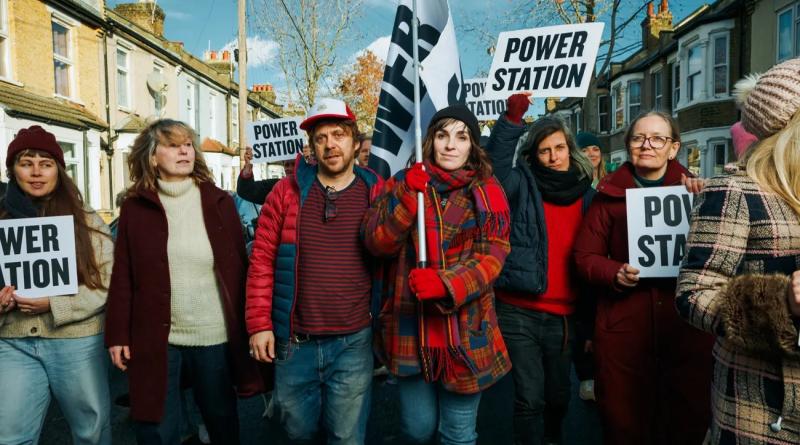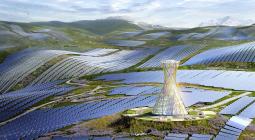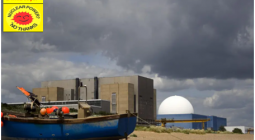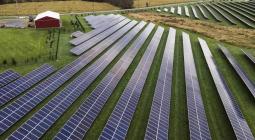Power to the people: the neighbours turning their London street into a solar power station

Lynmouth Road, Walthamstow, is about to become its own power station, with solar energy for 30 homes. Now the artists responsible want us all to change how we heat our homes
Lynmouth Road appears unremarkable. It consists largely of redbrick Victorian terraces. There are similar streets throughout the area, in Walthamstow, northeast London. Some houses are pebble-dashed. Some have doors painted in contemporary grey. There are wind chimes, geraniums in boxes, wheelie bins and the occasional cat sitting on a gate post. The only unusual feature is the number of windows displaying an A4 poster with the words “Power Station” printed in the font used by polling stations.
Power, in the sense of the energy, is at the forefront of everyone’s mind. Energy bills have reached record highs and are still rising, with the war in Ukraine highlighting how fragile energy supplies can be. This year’s Cop27 climate conference promised money to poorer countries to assist with damage caused by climate change, yet no agreement was reached on phasing out fossil fuels. The idea of cleaner power, generated closer to home, should feel like an obvious goal. But, at the moment, there are no large-scale programmes dedicated to making it happen. Instead, there are people like Dan Edelstyn and Hilary Powell.
These two are on the roof of their house, sitting on a bed they have just assembled. It is made up with a knitted blanket, bright sheets and a cheap foam mattress that is plastic-wrapped against the elements. Facing one way you can see their narrow back garden that ends when it hits the railway embankment. Turn around and you look down into their street, Lynmouth Road, which Dan and Hilary want to turn into a solar power station. They are living on their roof as a crowdfunder for the project. “I think it will be fine,” says Hilary, who has been scanning both the sky and the weather forecast. “I only get scared when the children say they want to come up, then I turn to jelly.”
The couple are artists and filmmakers. They live in the middle of the street, with their children, Esmé, 12, and George, 10, and the family’s two dogs. “It is a street that has a sense of community,” says Hilary, down from the roof and sitting at their kitchen table. “That became apparent with the Covid mutual aid group that was set up.” And it was during lockdown that a sentence from economist Ann Pettifor’s book, The Case for the Green New Deal, which makes a strong argument for total decarbonisation and a financial system based on fairness, struck both of them. The phrase was: “Every building a power station.” “We clung on to that,” says Hilary.
There was also People’s Power by American writer Ashley Dawson. “He wrote about energy democracy and tackling the power monopolies within the energy industry,” she adds
The idea started to take shape. Could they make a home into a power station? And not just their home, but perhaps their whole street by linking the houses together into a grid? Buying and installing a solar system for an average three-bedroom house costs around £10,000, they discovered. Linking them together would be hard – the technology is complex, especially in an urban area with lots of individual buildings. They did more research. And then they started talking to neighbours.
“Well, if someone came and said there was a way of helping with the bills, you’d be over the moon, wouldn’t you?” says Ejaz Hussain, 71, now retired. “If it comes off, I’ll know that I’ve been blessed.”
Sipke Visser, 45, is a photographer and retoucher. He lives with his wife, their two children and his father-in-law. “I know Dan and Hilary, so I wasn’t that surprised,” he says, “But I do think if a complete stranger were to knock on my door, I would be very sceptical.”
“We looked at putting solar panels up quite a few years ago and we found the cost of doing it was too much,” says Pippa Evans, 57, who works at an adoption and fostering therapeutic agency. “So I was intrigued when this flyer came through the letterbox. I wanted to know how it was going to work and if we could afford it. Were Dan and Hilary going to coordinate everything? I knew about their previous project. So I knew they were quite good at making things happen.”
The previous project was Bank Job. In 2018, the couple started working in an empty building, a former bank on one of Walthamstow’s main streets. They printed artwork that looked like bank notes, complete with pictures of people from local community projects, and sold them, raising £40,000 in the process. Half the money went back to the local groups. And with the remaining £20,000 they bought up £1.2m worth of high-interest debt owed by people in the local community. “You can buy it for so much less because the assumption is that it won’t be paid off,” says Dan. They let the debtors know there was nothing left to pay, although GDPR rules meant this could only be done by sending letters via a debt broker. Then they packed up the paper records into a gold-coloured van and blew the whole thing up on wasteland outside Canary Wharf, the towers of the UK’s financial sector looming in the background. The documentary they made about the project came out in 2021 and the remains of the van are currently on display at the Fitzwilliam Museum in Cambridge.
They describe Power Station as a natural evolution. “It’s also a show-and-do project,” says Dan. “We’re learning as we go and we’re sharing it as we learn it.”
“We’re not setting ourselves up as experts,” adds Hilary. “There isn’t just one solution and we don’t know everything about kilowatts per hour, so we’re a conduit. We’re learning and educating ourselves and others and then also building partnerships with people who are experts.” Their own expertise, they say, is in making a project come to life and then drawing attention to the issues using art and storytelling.
As of 2019 there were around 300 community energy projects in the UK covering 67,000 homes, according to the thinktank Green Alliance. The sector was hit when the government’s community energy strategy was scrapped, with at least 66 projects folding in 2017 and more becoming precarious. The initial grand design for Lynmouth Road was for an entire street interlinked, powered for free and managed by a cooperative. But the mixture of rented and private, leasehold and freehold, and various mortgages with various banks meant dropping uniform infrastructure across the rooftops would be almost impossible. “It turns out that not many people fully own their roof,” says Dan.
While the whole street can’t be linked now, Dan harbours a dream of making this happen as the project grows and would love to see a community battery so that those who can’t have solar panels could also access power. And with 30 households involved – nearly half the residencies in Lynmouth Road – there is enough for the street to become a solar energy hotspot and model for what other streets could also achieve in terms of renewable power.
The project, as it stands, will be funded in various ways. There are grants from organisations, such as the London Community Energy Fund. There’s the crowdfunder, running while Dan and Hilary sleep on top of their house. They have also printed a new run of bank notes to sell, the notes and large handprinting machines currently occupying half of their living room. Buying solar equipment in bulk brings the price down, so participating residents can offer to pay, but the scheme is free for those who need it to be. Each resident will be given a grant for their solar installation and deal with the company directly.
As we sit on the bed on the roof, the surveyor from the solar company is finishing his assessments. He climbs the scaffolding at the back of the house to come and chat, although he doesn’t make it all the way up. “It’s a bit ironic, in my line of work, but I’m not great with heights,” he says.
Not everyone in the street has wanted or been able to take part. “Some people just shut the door before we started speaking,” says Dan. “Then there were people who were dying or divorcing or moving. Or having a loft conversion.” Loft conversions came up a lot. They can make rooftops unsuitable for solar panels, but the more frequent issue was that of imminent building work.
Andy Richford, 70, is one of the people planning a loft conversion. An editorial consultant working in scientific publishing and with a background in ecology, he believes the project will amplify a necessary message. “I’ve been banging on about it for years,” he says. “I might not be able to participate in terms of getting the panels, but making a difference is important to me. Putting solar panels on top of houses, with a direct feed into the house, means energy isn’t lost in transmission and we don’t have the worry of covering acres and acres of farmland or wild land.”
The ground on which Lynmouth Road stands was once part of the marshland on the banks of the River Lea. The remaining marsh is less than half a mile away, some of it a Site of Special Scientific Interest and all of it popular with picnickers, dog walkers, runners and the occasional raver. The Lynmouth Road area, says Hilary, who has been looking into its history, was a watercress farm until the houses started going up in 1886. The Victorian era was Walthamstow’s first growth spurt. Boosted by new rail links, the land filled up with houses for workers. It remained a largely working-class area for most of the 20th century, but in the 2000s house prices accelerated andWalthamstow, with its garden terraces, good schools and decent transport links, became a prime location. Between 2012 and 2019, house prices more than doubled.
“It used to be full of very long-term residents,” says Hilary. “One family staying in a house for decades. We moved in around 14 years ago and found a newspaper from 1945.” Dan also mentions a former resident, Dorothy Burroughs, who spent her 100 years living on the street, only leaving to briefly enter a care home before her death last year. Dorothy remembered when electricity first came to the houses in the 1930s. “She said that people needed to be shown what to do and how to use appliances. People would come round and demonstrate.”
Ejaz Hussain has lived here since 1978. He has worked all of his adult life, including 20 years at a local food processing factory, now demolished to make way for flats. “I’m struggling, although the mortgage is paid. I’ve got two daughters, one at college, one about to go to university. We put them first. But the bills come in and the house needs repairs and I’m on my pension,” he says. Like many of his neighbours, he had also looked at solar panels, but had been unable to afford them. He has also watched the street change around him. “In the early days it was brilliant, simple. You said good morning to your neighbours, they said good morning to you. Then it got that if you said hello, people would give you a funny look.” The Power Station project, he says, has meant the people in the street talk to one another once more. “This is what we want, the community spirit,” he says. “It costs nothing to look after one another.”
The collective nature of the scheme has been a draw for many of the residents. “We all have concerns about the environment,” says Chris Humphreys, 49, who works in education and lives with his wife, Catherine, and their two sons. “And you try and do your little thing, but to be part of something bigger is very appealing. You see what’s happening in the news at the moment and you know it won’t be those people who make changes for the better. It’s got to start at the grassroots. I’ve never been especially active politically, but I’m very happy to stand alongside our neighbours in what I think is hopefully a practical and positive solution.”
“I want to be part of the solution, even if it’s just a small part,” says Dee Tweedie, 48, who has been involved with the project from the beginning and went door-to-door with Dan and Hilary to explain the idea. “We all want to save the planet and the prices of everything are rising in tandem… energy, food, mortgage. But you don’t always know what you can do when it’s just you and your family. It’s been lovely to meet so many of our neighbours. There’s camaraderie. Maybe that’s how it felt during the war.”
“It’s building on the sense of community that started to grow during the pandemic,” says Pippa Evans. “To me, it’s almost as important as the energy. It’s within human nature to be self-centred at times and I think the political climate has encouraged that. But humans are sociable and we’re interdependent and those aspects can be emphasised when we’re working together and helping create something. As a community, we can make bigger changes than as individual people.”
“The energy for what we do is drawn from anger, but I don’t think you would necessarily see that as a tone in our films or in our work,” says Dan. “But you wouldn’t see us here, doing all this, if we didn’t feel an intense sense of how absurd our political and social realities are. We’d like to see a kinder world, but we’ve created a system that profits a very narrow minority and so many more people could be living more meaningful and useful lives.”
“I can be really angry,” says Hilary. “We live in a society where Matt Hancock can be on celebrity TV and you think, ‘What the fuck is going on? This is sick, it’s like The Hunger Games. And we acquiesce. And the corruption and vandalism of those in charge are just forgotten. At the same time, we can’t be paralysed,” she continues. “I hope this can wake others up and make them realise you can take action, and that the worst thing would be to sit in despair and do nothing.”
The Power Station may not be actively producing energy just yet, but it has generated an idea that is already flowing to the rest of the area. Dan and Hilary are working with five local primary schools, including the one their son attends, to arrange funding and installation via the Solar for Schools project. People in neighbouring streets have started asking how they could join in.
“We’re busy behind the scenes, working out how it could become a street-by-street model,” says Hilary. “I hope, after the first wave, when there are people sharing testimonials, others will want to be involved, too.” On their wall they have an aerial photograph of the road, with the houses already involved marked by coloured Post-It notes.
“I was kind of heartbroken when the obstacles to doing the whole street started to pile up,” says Dan. “But I started to realise it doesn’t really matter. We have 30 households, and more and more people expressing interest. Three nearby streets are starting to organise themselves. And we can share what we’ve learned. You need someone to coordinate, otherwise scheduling the surveys is tough. You need at least 20 people. But you can go from there.”
The surveys on Lynmouth Road are just wrapping up. If all goes to plan, the panels will start to go up in January. “I feel like we’ve promised people something and I want everyone to see it’s really happening,” says Hilary. But even without the solar panels, the street has started to change. “When society is organised from the top down, you feel reliant on the government to change things,” says Pippa Evans. “But if you have brave individuals who stand up and gather other people around them… We can stand up for ourselves, we can do things ourselves.”
“We can be powerful, us, the people who should be powerless,” says Dan. He is on his rooftop with the street – and the geraniums and cats and wheelie bins – spread out two storeys below. “We do have the power to change things.”
For all information on the Power Station, go to power.film. To contribute to the project, visit crowdfunder.co.uk/p/power-station. For free access to the membership scheme and to learn how to do it A, B, C style, go to membership.power.film
cover photo: Artists in residence: Dan Edelstyn and Hilary Powell with some of their Lynmouth Road neighbours. Photograph: Charlie Clift/The Observer





